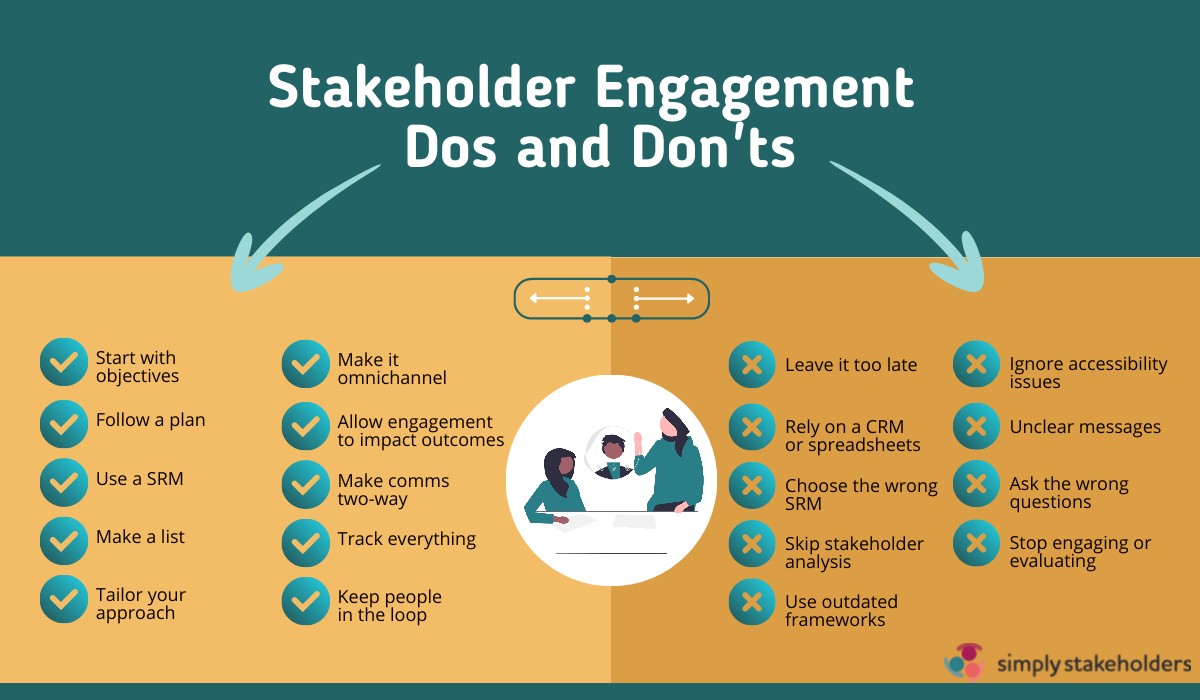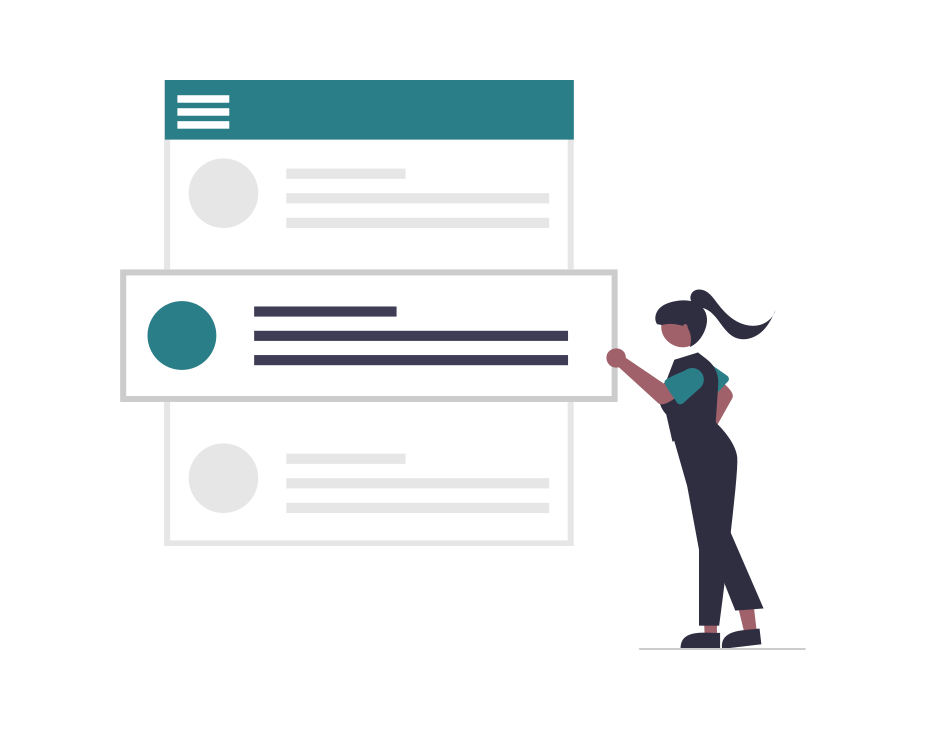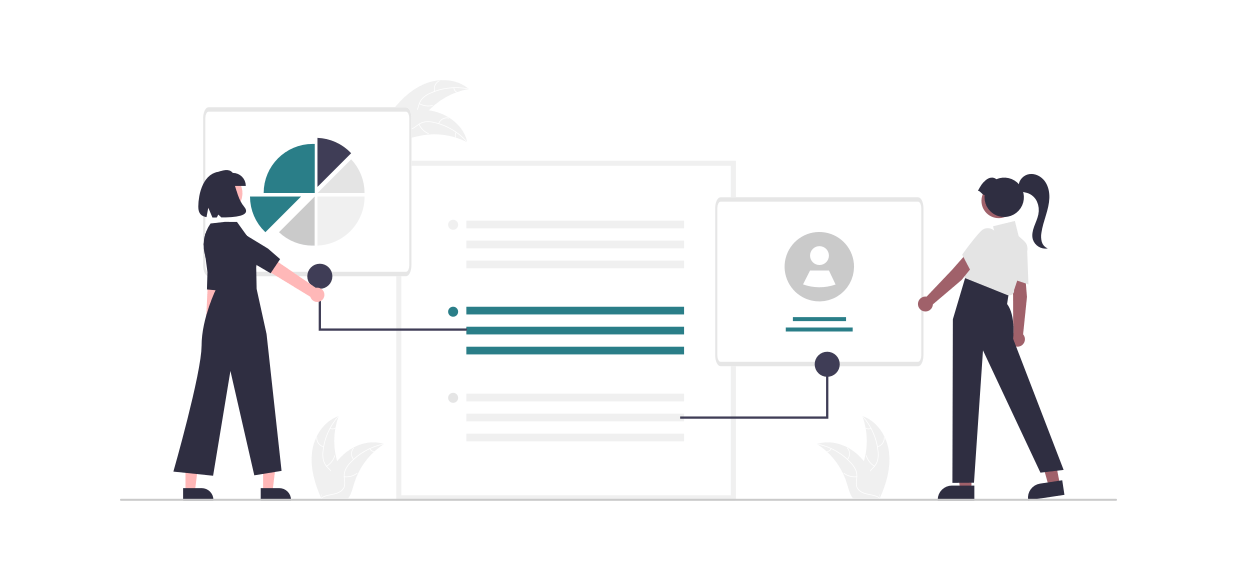Stakeholder Engagement Tips: The Dos and Don’ts

Looking for a quick guide to stakeholder engagement? Some stakeholder engagement tips that might help someone new to the sector get through your first few weeks or months? A sort of cheatsheet for things you should and shouldn’t do?
We’ve got you covered.
Here’s a list of 10 things you should do and nine things you shouldn’t do as a stakeholder or consultation professional. It sums up many of the principles and best practices we’ve covered elsewhere:

Side note: if you’re looking for something more in-depth, check out our guide to stakeholder engagement principles!
But now, let’s expand on each of the dos and don’ts in the list. To kick off these stakeholder engagement tips, let’s talk about something that can make all the difference from the start of your engagement…
DO: Start With Objectives
It might be tempting to dive into engaging your stakeholders, but the first thing every stakeholder professional must do is set some objectives. These will help guide everything else, from your stakeholder engagement plan and activities to your measurement and reporting.
What do you want to achieve from engaging with stakeholders? What measurable outcomes would you like to see for your project, organization, or stakeholder groups? How will you know if your plan and processes are successful?
Be specific and realistic about what you can achieve.
DON’T: Leave it Too Late
One of the most common stakeholder engagement mistakes is leaving it too late to get started. The problem with engaging too late is:
- Many decisions have already been made
- Impacted stakeholders have limited scope to influence the outcome
- Your organization misses out on ideas and insights that could actually help achieve better outcomes
In fact, in IFC’s stakeholder consultation guide, one of their 11 principles of good practice is to ‘start consultation as soon as possible so that you can scope out the major issues and allow stakeholders to influence the decisions that impact them.’ And another is to ‘ensure that stakeholders get relevant information in advance.’
DO: Follow a Plan

Benjamin Franklin is known for saying, “by failing to plan, you are preparing to fail.” And this certainly rings true with stakeholder engagement.
After setting your objectives, your next step is to make a stakeholder engagement plan. This doesn’t have to be a 30-page monstrosity — actually, we find that a one-page plan is much more likely to get read and implemented. It mainly needs to cover the basics:
- Who your stakeholders are
- Why you need to engage them
- What methods you’ll use
- What outcomes you’re aiming for
This will allow you to plan for the resources and capacity your organization needs to engage stakeholders — and the steps you need to work through, from stakeholder identification and analysis to measurement and reporting. It also ensures that every action you take is in line with your strategy and desired outcomes.
If you’d like to learn more, watch our webinar on stakeholder management plans.
DON’T: Rely on Spreadsheets or Use a CRM
There are many reasons why you shouldn’t use spreadsheets for stakeholder engagement. They’re hard to collaborate in, not very secure, difficult to share (without version control issues), and lack very useful features like analysis, tracking, reporting, and automation. Once you get beyond a handful of stakeholders, it’s just not practical to manually enter their information into spreadsheets.
CRMs (Customer Relationship Management Systems) are another tool commonly used to manage their stakeholders, but as they’re built for sales teams to convert customers (and not stakeholder professionals to engage stakeholders), they lack some very useful functions. In particular, they fall short on stakeholder mapping, stakeholder analysis, and reporting. Plus, many CRMs are loaded with features that aren’t relevant for stakeholder management, which makes them bloated and overwhelming to use.
Learn more about the problems with spreadsheets and signs you’ve outgrown your CRM.
DO: Use a SRM
SRMs (Stakeholder Relationship Management Systems) are the ideal tool for most stakeholder engagements. They’ll help you engage stakeholders more effectively and efficiently — and stakeholder software will very likely deliver an ROI. Inside your stakeholder system, you should be able to
- Record contact details
- Record communication with each stakeholder
- Analyze stakeholders
- Assess and track sentiment
- Track issues
- Communicate with stakeholders
- Create reports
No matter how big or small your team, stakeholder software is one of the best ways to make the most of your time and resources, and increase your chances of a successful engagement.
Check out these tips for successfully implementing stakeholder software!
DON’T: Choose the Wrong SRM
When comparing your options for SRMs, you’ll notice that a lot of them share the same X core functionalities:
- Stakeholder lists with contact information
- List importing and exporting
- Communication records (e.g. emails stakeholders have sent and received)
- Analysis and reports
And most of them cost roughly the same amount per user.
What sets each software provider apart is things like:
- User-friendliness – How easy is it for people to learn the software and use it on a daily basis? Is it accessible on multiple devices?
- Flexibility – Can you add custom fields and tags to make it work for you?
- Structure – How are the stakeholder records, interactions, and reports organized or linked together?
- Integrations – Can you integrate it with other tools you use, including email platforms, SMS providers, social media, surveys, and more? Can you expand on native integrations with API access and/or Zapier?
- Analysis – Does it offer qualitative analysis as well as quantitative analysis? How can you map stakeholders and put them into groups for analysis and/or tailored communication?
- Reporting – Does it offer data visualizations or automated report generation?
- Collaboration – How does it support your team to work together on tasks? Or across multiple engagements and projects?
- Support – What kind of training is offered? Do you get a dedicated customer success manager? What’s tech support like if we run into issues?
It’s a good idea to demo a few different options to get a feel for what’s going to be the best fit for your organization, project, and team. Learn more about what to look for when investing in engagement software or check out some of Simply Stakeholders’ features. And if you’d like to request a demo, reach out to our team when you’re ready.
DO: Make a List and Check it Twice
What does a stakeholder professional and Santa Claus have in common? They both make lists! 🥁 You can pocket that cheesy joke for a future office Christmas party…
Most people realize that stakeholder identification is part of stakeholder engagement. But after you make your list, you’ll very likely end up with more individuals, groups, and organizations than you can properly engage with. So, go back to your original list and determine who your key stakeholders are — the people and groups you need to engage with more regularly, or who you need to participate in your project, because they have a higher level of influence, impact, and/or interest. But to do that properly, you’ll first need to do some careful analysis and mapping…
DON’T: Skip Stakeholder Analysis

Now that you’ve got your stakeholder list… you’re all set, right? Wrong. It’s time to dig deeper and get to know who those stakeholders are.
Stakeholder analysis involves understanding each stakeholder’s interest in and influence on the project, and how your project or work will affect them. Likewise, stakeholder mapping can help you make sense of your analysis by plotting the data onto charts. From there, you can organize stakeholders by shared attributes, identify trends, compare stakeholders, segment them into groups, and prioritize your key stakeholders.
One more thing… don’t just do your stakeholder analysis, but make sure you actually refer to the insights and use them to inform your stakeholder approach and decisions! This is one critical mistake that almost everyone makes — but now you know, so you don’t have to.
DO: Tailor Your Approach
A tailored approach to stakeholder engagement means treating each stakeholder group according to their needs, interests, and preferences. For instance:
- Focusing on issues that matter to them (or that they can influence)
- Communicating in a way that’s relevant to them (based on their location, language, culture, and more)
- Communicating more frequently and/or individually with key stakeholders
- Focusing on specific groups first (e.g. those most likely to oppose your project, or those with the most influence)
- Using more scaled-up communication methods (e.g. bulk emails) with less critical stakeholders
- Communicating via their preferred channel (email, SMS, phone, social media, face-to-face, etc.)
This means that you can make the most of your limited resources (in particular, your time) and make sure that you engage with stakeholders in a way that is most relevant to them.
This stakeholder tip fits nicely with IFC’s 11 principles of good practice. In particular, tailored communication can help to ensure that your consultation is targeted (reaching those stakeholders most likely to be impacted) and localized (reflecting local languages, context, and timeframes).
DON’T: Use Outdated Frameworks

Many of the popular stakeholder engagement frameworks used to guide and evaluate consultation are outdated. For example, the IAP2 Public Participation Spectrum hasn’t kept up with how expectations for engagements have evolved and grown over the last couple of decades. Plus, it’s structured in a way that it could tempt organizations to focus on doing the bare minimum level of engagement.
If you’re looking for something more modern, check out our Evaluation Framework, which covers key indicators of good community engagement across the core principles of integrity, inclusion, deliberation, influence, capacity building, and sustainable decisions. It can be used to guide your engagement approach from the beginning, and then to evaluate the success of your engagement (either at the end, or on a regular basis). We share a copy of this framework inside our eBook, Evaluating Stakeholder Engagements and Public Consultation.
DO: Make it Omnichannel
These days, it isn’t enough to offer one method of communication and engagement with your stakeholders. Embrace an omnichannel approach, bringing in a mix of:
- Traditional approaches – Face-to-face meetings, focus groups, events, letterbox drops, phone calls, offline surveys
- Digital communication – Emails, SMS, social media, forums, online surveys, video
This will ensure that you are more likely to reach all your stakeholder groups (and get a broad variety of perspectives), and that your engagement gets noticed by the right people.
DON’T: Ignore Accessibility Issues
Speaking of reaching all your stakeholder groups, accessibility issues are an important consideration for your engagement to ensure you are fair, inclusive, and able to hear from a variety of perspectives). Important considerations for accessibility and inclusiveness include:
- Physical access – Can people with physical disabilities participate in the event? How can their needs be accommodated? What location(s) are ideal to reach most stakeholders?
- Timing – Do you offer a variety of timeslots to suit a variety of work schedules, timezones, and other commitments?
- Information formats – Is the information available in a variety of formats, including text, video, audio, and multiple languages (if relevant)?
- Feedback formats – Can people offer feedback in a variety of ways, including face-to-face, paper-based forms, online forms, email, phone, and more?
- Digital literacy – Can people participate in your engagement without a computer or smartphone (or the ability/desire to use one)?
- Culture – How can you make the information and activities culturally relevant?
Consider asking stakeholders about their needs and preferences so that you can take these into account.
DO: Allow Engagement to Impact Outcomes
One of the main reasons to do stakeholder engagement is to inform and influence decisions — because stakeholders often have insights and perspectives that help lead to better outcomes.
But if you engage with stakeholders but have no intention to allow their feedback and ideas to actually impact your project… you may as well call it a sophisticated communications or PR campaign.
Genuine stakeholder engagement welcomes feedback and considers stakeholder contributions, concerns, and perspectives. And at the end of your engagement, you should be able to show how your policies, projects, and decisions were shaped by your stakeholders.
DON’T: Communicate Without Clear Messages
Before you begin reaching out to stakeholders, get clear on the messages you need to communicate. Stick to the facts to help avoid confusion and uncertainty. Most of your communications will need to clearly address:
- What’s happening
- When it’s happening
- How it impacts them
- What they can do
- Your role
- How they can contact you
- When they can expect to hear from you next
It’s always a good idea to look at your letter, email, or post with fresh eyes before you send it. Anticipate questions and concerns your stakeholders may have based on the information and, if possible, address them in your communication.
DO: Make Communication Two-Way
Make sure that stakeholders have plenty of opportunities to respond to your messages and announcements. Tell them how to add comments, ask questions, and share information. Facilitate back-and-forth conversations. Listen to their thoughts, feedback, and grievances — and be sure to respond to them in a thoughtful way.
DON’T: Ask the Wrong Questions

Carefully consider the questions you put into stakeholder surveys to ensure that you are gathering meaningful insights from stakeholders. For example, don’t ask questions about things that can’t be changed — these serve no purpose. Instead, look for potential compromises and focus on issues that your stakeholders can impact.
DO: Track Everything
In IFC’s 11 principles of good practice, they identify that consultations should be documented and reported. In other words, you should keep track of who you’ve engaged with, any interactions, and any key issues they’ve raised. Plus, ensure you provide timely reports to stakeholders, sharing any outcomes and your next steps. Tracking and reporting is much easier to do with stakeholder engagement software like Simply Stakeholders because:
- It can automate most of the steps
- It links each interaction to the relevant stakeholder contact
- It shows trends and key issues
- It easily generates reports
DON’T: Stop Engaging or Evaluating
Most of the time, stakeholder engagement is an ongoing process that can actually deliver more value over time. So, don’t stop engaging! Even after your project finishes, it’s a good idea to remain in touch with stakeholders and hold onto the records you’ve collected, because these can be valuable for future projects, too.
On that note, you should also continue to evaluate and adapt your approach as you go along. The sooner you adapt to changes in the environment, new stakeholder preferences, and stakeholder feedback, the better.
DO: Keep People in the Loop
Don’t forget to update your stakeholders on how you went with the project or work you’ve been engaging them on! Produce reports and share regular updates so that stakeholders can see the final outcomes and how they played a role. If you do a good job of keeping them in the loop, they may just stick around for future projects, too.
Learn More
We’ve covered a lot of stakeholder engagement tips, but if you’d like to dive deeper into any of these topics, why not check out the following resources?






























